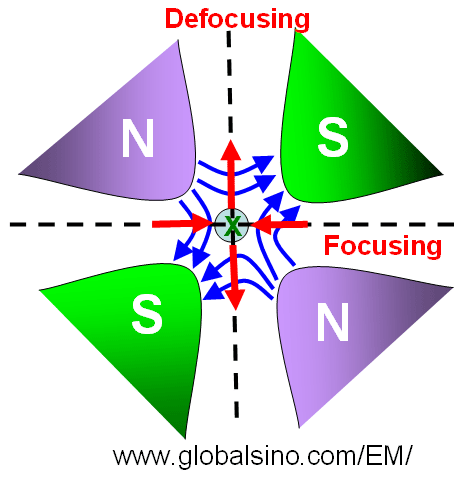=================================================================================
The electromagnetic lenses in electron microscopes can be used
to focus them into very small probe diameter (1 nm or
even 0.1 nm) or to produce a electron image of the
specimen, with a spatial resolution down to atomic dimensions in TEM systems. The focusing properties of a lens may be given in terms of a parameter k2,
 ---------------------------------------- [4900] ---------------------------------------- [4900]
where,
Bm -- The maximum value of the magnetic induction between the polepieces.
l -- A length characteristic of the lens, which can be the half-width of the axial magnetic field distribution, or the polepiece gap S or the radius R of the bore through polepieces.
K -- A numerical factor incorporating the charge and mass of the electron.
Vr -- The relativistically corrected value of the electron beam voltage.
As illustrated in Figure 4900a, a current through a set of symmetrical windings around the electron-optical axis can generate strong magnetic field produced by a conventional magnetic lens. This field acts as a convex lens in electron microscopes, bringing off axis rays back to focus. The coil is enclosed by a soft iron shield (pole pieces) apart from
a narrow gap between a pair of pole pieces across which the focusing field appears. The magnitude of
this current in the lenses determines the strength of the lens expressed by the focal length. The image is rotated to a degree that depends on the strength of the lens.
Furthermore, focal length of the lenses can be altered by changing the strength of the current. Electrons travelling initially
parallel to the electron-optical axis experience a tangential
force due to the interaction of the axial velocity with the radial component of
the magnetic field as shown in Equation [4919c]. Therefore, the subsequent direction of moving electrons is
inclined to the electron-optical axis, and the tangential velocity component interacts
with the axial component of the field to produce a radial force toward the optical axis. The
resulting electron paths are helical and, as the field action becomes stronger with increasing distance from the optical axis, a crossover of the electron paths in
the lens focus results. An image rotation caused
by the helical paths of the electrons within the focusing magnetic field is a typical feature of the action of a magnetic lens.
It is also worth mentioning that EM (electron microscope) operators can observe image rotation in some cases because of adding an extra lens when changing magnification.
For the people who want to have advanced study, we quantify the rotation angle below. The Lorentz force of moving electron results in a helical
rotation of the electron trajectory. The rotational velocity component rθ
(out of the page in direction) interacts with the z component, as shown in Figure 4900a, of the field Bz(r) to produce a force component towards the axis. This force is responsible for the focusing action of
the lens.

Figure 4900a. Convex electromagnetic lens.
Note that in a round magnetic lens, the focusing effect of the magnetic field increases too quickly with distance from the optical axis and the high angle rays are focused much more strongly. That is, there will always be significant aberrations if the lens is round.
Figure 4900b shows a quadrupole design which can be used to focus the beam into a line. The optical axis, along which the electrons travel, is into the page.  indicates the direction of the electron beam. The blue lines represent the magnetic field lines, while the red line represents the Lorentz force on the electrons. indicates the direction of the electron beam. The blue lines represent the magnetic field lines, while the red line represents the Lorentz force on the electrons.

Figure 4900b. A quadrupole design which can be used to focus the beam into a line.
|